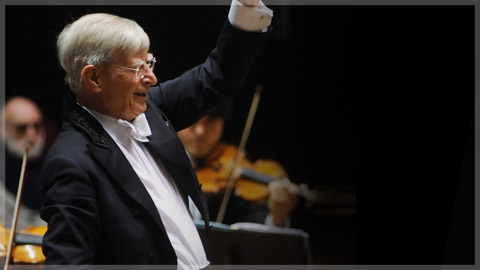by Peter Feher

The mix of curiosity and thoroughness that’s sustained Blomstedt throughout his career was just as apparent in his program with The Cleveland Orchestra on February 16. If he’s slowed down somewhat since his last appearance here — the biggest change is that he now conducts seated at the podium — there was nonetheless a sense of coming full circle as he led Beethoven’s Seventh Symphony.
Blomstedt’s journey with Beethoven is well documented. He’s recorded the composer’s complete symphonies twice, and the differences between the two cycles — made four decades apart — correspond to a steady and thoughtful evolution on the conductor’s part. In general, he’s moved toward faster, fleeter, and punchier readings, which he credits to recent editions of the scores that restore Beethoven’s original (and very speedy) metronome markings. Cleveland audiences are more than familiar with Blomstedt’s later style thanks to his regular visits here, including a top-notch performance of the Seventh at Blossom Music Center in 2021.
So it was surprising, but also fitting, that Blomstedt returned to the older, slower tempos at Severance on Thursday. This is the approach that first made an impression on the young conductor and that years later can still illuminate a score.
When taken at a more deliberate pace, the Seventh Symphony unfolds as a grand work structured by its simplest elements. Plenty of interpretations have dwelled on the Allegretto, a movement of intense economy and emotion, but Blomstedt extended this way of thinking to the entire piece. Right from the start, he let individual chords ring out with maximum impact, and he allowed pauses to punctuate sections of understated significance. Naturally, he communicated everything through gestures as minimal as could be, and the Orchestra’s woodwinds and strings responded with their most brilliant sound.
There were drawbacks to slowing the symphony to this speed. The development of the first movement occasionally dragged, the scherzo and trio bordered on repetitive, and the perpetual motion machine of the finale lost some of its momentum. The brass struggled to play out in a couple of climaxes, but the strengths of this performance lay elsewhere, in moments like a single note cued expertly from the podium.
The evening had no shortage of authority, with Emanuel Ax soloing in Mozart’s Piano Concerto No. 18 (“Paradis”) on the program’s first half. At 73, Ax was practically the young one onstage, though he brought a certain rigidity to his part, treating Mozart’s melodies neatly, plainly, and in more or less the same way as he did on his 1982 recording of the piece. He broke free with his encore, Franz Liszt’s arrangement of Schubert’s Ständchen, D. 889, creating that feeling of immediacy that’s essential for any effective performance.
Published on ClevelandClassical.com February 28, 2023.
Click here for a printable copy of this article



